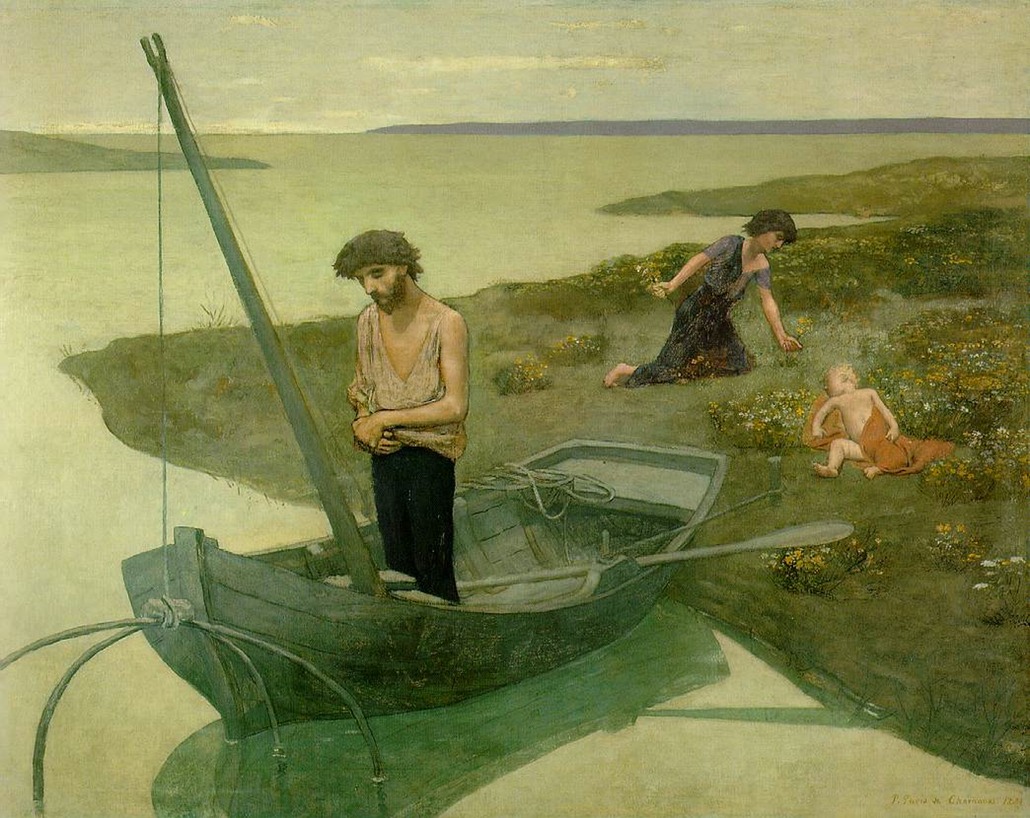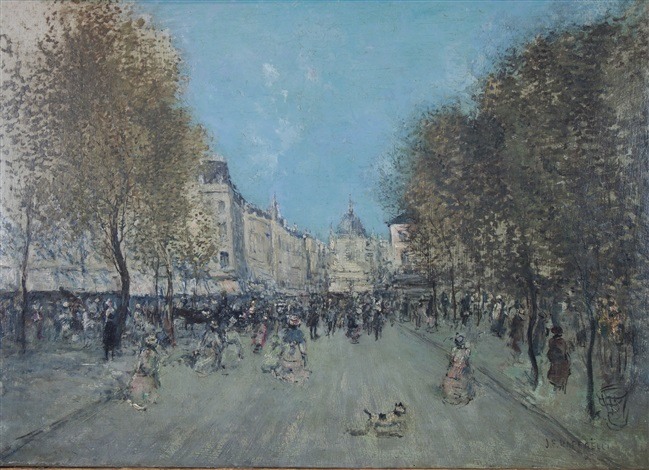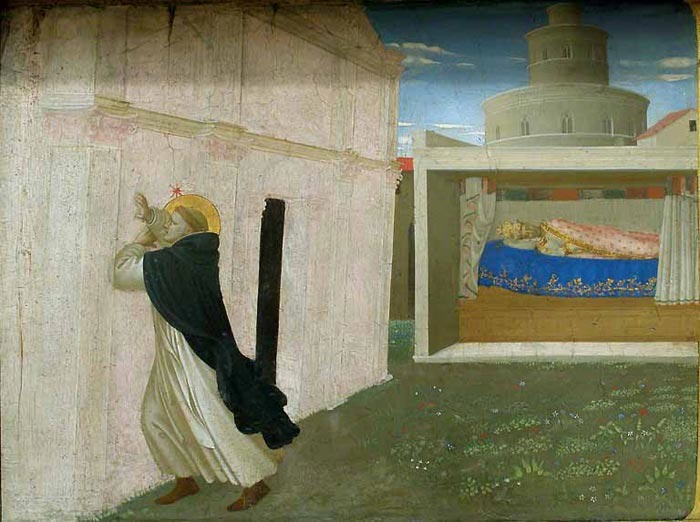Denis's introduction: Art et critique, 23 and 30 August, 1890. I was not yet 20 years of age. I had been a pupil at the École des Beaux-Arts since July, 1888. This article was signed Pierre Louis, a pseudonym which I abandoned at the request of M. Pierre Louys, future author of Aphrodite.
DEFINING 'NATURE'
I
Remember that a picture - before it becomes a battle-horse, a nude woman or any sort of anecdote - is essentially a flat surface covered by colours arranged in a certain order.
II
I am looking for a painter's definition of the simple word "nature" which serves both to indicate and to summarise the theory of art that is most generally accepted in this end of the century.
Probably: the sum total of our optical sensations? But, without speaking of the natural disturbances of the modern eye, who does not know the power that our mental habits exercise over our vision? I have known young persons who have given themselves up to a tiring gymnastic of the optic nerves just in order to observe the various trompe-l’oeil devices used in the Poor Fisherman. (1) And they succeeded, I know. M. Signac will prove to you with impeccable science that his chromatic perceptions are entirely necessary. And even if the corrections he makes in the studio are done in all sincerity, M. Bouguereau is intimately persuaded that he copies "nature."
(1) Well-known painting (1881) by Puvis de Chavannes.

Ill
Go to the Museum and consider each canvas separately, in isolation from the others: each will provide you with a complete illusion, at least with an appearance of nature that has pretensions to being true. You will see in each picture whatever it was you wanted to see.
But if, by an effort of the will, one can see "nature" in paintings, the opposite is also true. It is an irresistible characteristic of painters to refer what is perceived in reality back to what has been seen previously in paintings.
It is impossible to give an idea of all the factors that can affect our modern way of seeing things, but there can be no doubt that the storm of intellectualism through which most young artists pass ends by creating some very real optical anomalies. After looking for a long time to see if they are violet or not, certain greys will appear very clearly to be violet. (2)
(2) Denis is presumably referring to the ability of grey to assume the complementary of colours juxtaposed with it. Thus a grey surrounded by yellow would yield a violet. This was a subject of great excitement among the colour theorists of the time. Although it is an undoubted fact, Denis seems to be expressing skepticism on the subject.
The eyes of the academic masters have certainly been deformed by their unreflecting admiration for old paintings. They admire them because they have to, but what they have tried to see in them is a careful rendering of "nature". Other disturbances come about through the admiration of modern painting, studied with enthusiasm in the same spirit. Has no-one noticed that this indefinable "nature" is changing all the time, that it is not the same in the salon of 1890 as it was in the salons of thirty years ago, that there is a fashion in "nature" - a fantasy that changes, after the manner of clothing or of hats?
IV
Thus, by a process of choice and of synthesis, there is formed in the modern artist a certain habit of interpreting optical sensations that is both eclectic and exclusive, and this - the individual self-definition of the painter which the literary types would later call the 'temperament' - becomes the criterion of naturalism. It is a sort of hallucination. Aesthetics have no part to play, since reason has surrendered to it and is no longer in control.
When we say that Nature is beautiful, more beautiful than any painting, then, supposing we remain within the realm of aesthetic judgement, what we mean is that our own impressions of nature are better than those of other people. That's something we have to admit. But do we want to compare the imagined, dreamt fulness of the original effect with the way that effect has been recorded by such and such a mind? Then the great question of temperament is posed: "Art is nature seen through a temperament." (3)
(3) Apparently a reference to the definition by Zola: 'A work of art is a corner of creation seen through a temperament'. The quotation occurs in two articles reproduced in Emile Zola: Mes Haines - causeries littéraires et artistiques. Mon Salon 1866 and Edouard Manet, étude biographique et critique, Paris, Bibliothèque Charpentier, 1893 (first published in 1866): "Ma définition d'une oeuvre d'art serait, si je la formulais : Une oeuvre d'art est un coin de la création vu à travers un tempérament. Que m'importe le reste.' Emile Zola: 'Proudhon et Courbet' in Mes Haines p.25 originally in the Lyon based paper Le Salon Public, 26 July and 31 August, 1865 'Ainsi, il est bien convenu que l'artiste se place devant la nature, qu'il la copie en l'interprétant, qu'il est plus ou moins réel selon ses yeux; en un mot, qu'il a pour missiôn de nous rendre les objets tels qu'il les voit, appuyant sur tel détail, créant à nouveau. J'exprimerai toute ma pensée en disant qu'une oeuvre d'art est un coin de la création vu à travers un tempérament.' Emile Zola: 'M.H.Taine, artiste' in Mes Haines p.229, originally in La Revue contemporain, 15 February 1866. It may have been Denis himself who replaced 'coin de la création' with 'la nature'.
A definition that is very true because it is very vague, and which leaves uncertain the principal point: how do we judge the quality of the temperament? M. Bouguereau’s painting is nature seen through a temperament.
M. Raffaëlli is an extraordinary observer, but strongly aware of beautiful forms and colours, don’t you think? Where does the "painterly" temperament begin or end?

Jean François Raffaëlli (1850–1924): Boulevard Malesherbes, Paris, 1890
There is a science - do we know it? - which covers these things: Aesthetics, which is becoming precise and which, thanks to the practical researches of Charles Henry, is firmly based on the psychology of the Spencers and the Bains. (4)
(4) Charles Henry (1859 - 1926) was a mathematician who argued that aesthetic sensations could be expressed mathematically. He exercised a considerable influence on the painters Seurat and Signac, and the theorist Félix Fénéon in the late nineteenth century and in the 1920s on Gleizes and Severini. Herbert Spencer (1829 - 1903): Denis probably has principally in mind his Principles of Psychology, published in 1855. Alexander Bain (1818 - 1903), Scottish philosopher, friend and associate of John Stuart Mill, wrote extensively on the relation between physiology and psychology.
Before manifesting our sensations, such as they are, to the outside world, we ought to determine their worth from the standpoint of beauty.
VI
I don't know why painters have so badly misunderstood the epithet "naturalist ", which has been applied, but uniquely in a philosophical sense, to the Renaissance.
I will admit that Fra Angelico’s Predella at the Louvre, (5) Ghirlandaio’s Man in Red and a number of other works by the primitives, recall "nature" much more readily to me than Giorgione, Raphael or Da Vinci. It is another way of looking - those are different ways in which the imagination works.
(5) The paintings in the frame below Fra Angelico's Coronation of the Virgin (1434-5), showing scenes from the life of St Dominic. They include the Dream of Innocent III. This picture comes from the excellent website http://www.travelingintuscany.com/engels/artintuscany.htm

VII
And then, everything in our sensations, subject and object, is always changing. One must have a very strictly disciplined mind to be able to see the same model upon the table two days in a row. There is life, intensity of the colour, light, mobility, air, a host of things which can't be rendered. Here I arrive at themes that are well known and very true, indeed quite obvious.
VIII
I recognise finally that there are many possibilities that some sort of universal agreement, here as in other intractable problems, might have some value - that photography might, more or less, convey the reality of a form and that a direct moulding is as "close to nature" as we can get.
Of those works and of others like them, I shall say that they are "nature". I shall call "nature " the trompe-l’oeil of the herd, like the ancient painter’s grapes, pecked by the birds, and M. Detaille’s (6) panoramas, where one wonders - oh the aesthetic emotion! - if such and such an ammunition chest in the foreground is real or on the canvas.
(6) See fn (19)